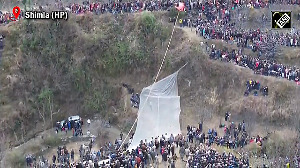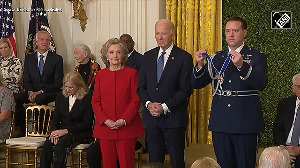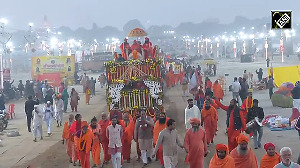It's been a tough few months for Rajesh Mehrotra, a Mumbai-based businessman with interests in shipping and travel. Freight rates are down, and the market for corporate incentive trips, his agencies' speciality, has all but dried up as India's economy decelerates in tandem with the global economic slowdown.
Yet his business worries did not prevent Mehrotra from spending a recent afternoon with his wife and 21-year-old daughter Karishma at the boutique of top Indian luxury couturier Tarun Tahiliani, shopping for outfits for an upcoming family wedding.
Under her parents' approving eyes, Karishma modelled different lenghas and cholis (traditional Indian skirts and tight-fitting cropped tops) before they settled on a striking, rich turquoise-blue with lavish gold embroidery, and a second outfit set with colourful jewels stitched into a creamy-gold background, for her to wear to her cousin's wedding.
Admittedly, the Mehrotras had timed their visit to coincide with the start of the annual end-of-season sale -- which had drawn a rush of other Mumbai elites to the showroom, located in an elegant colonial-era sea-front apartment building facing the Arabian Sea and the Gateway of India. But sale or no sale, Mehrotra says he wouldn't stint on his daughter's outfits. "The recession does hurt, but she gets what she wants to get," he says. "She has me wrapped around her finger."
Mumbai, India's glittering, yet elegant, business and entertainment capital, suffered a big psychological blow during last November's terror attacks. Since the attacks, the city has also felt the worsening impact of the global downturn, and the shock of a major fraud at one of the country's biggest IT outsourcing companies, the sector most emblematic of India's aspirations.
Yet in a city where the sweeping arc of the sea-front Marine Drive is also known as the "Queen's Necklace" due to the streetlights' night-time resemblance to a string of jewels, fashion remains a priority.
"The super-high end is very marginally affected," says Tina Tahiliani-Parikh, the designer's sister and director of Ensemble, a haute couture showcase for all of India's leading contemporary designers. "It's almost a recession-proof sector."
Like other residents of the city, Ms Tahiliani-Parikh was shocked by the Mumbai terrorist attacks -- and worried about their impact on business. The Tarun Tahiliani boutique is just a stone's throw from the historic Taj Mahal Hotel, which, along with the Oberoi, was one of Mumbai's main venues for large social functions and a main target for the terrorists. But Tahiliani-Parikh says she was determined to reopen the boutique quickly after the attacks, so as not to "give in to the terrorists" and also to lift the city's spirits.
"I did think, with the Taj and the Oberoi both gone, where are people going to wear our clothes?" she says. "But people who have weddings in their family are still coming to place orders. We've managed to keep our heads well above water."
India's tradition of large, lavish weddings with multiple functions continues to give its elites plenty of impetus to shop. This tends to favour well-established designers such as Tarun Tahiliani, who is well-known for reinterpreting India's traditional crafts heritage for contemporary tastes.
"With luxury in India, it's not about keeping up with the Joneses, but you can't afford to go down a step," says Mehrotra, a self-confessed shopaholic, who prefers Western brands to Indian designers. "India is very brand conscious."
Yet consumers are also becoming more cost-conscious, putting pressure on designers to offer more for less. "Every designer has felt it," says veteran Mumbai couturier Neeta Lulla, who also creates costumes for lavish Bollywood epics, and has dressed top Indian film stars such as Aishwarya Rai.
Lulla, who says sales have declined 20 to 30 per cent at her boutiques, also says even affluent Indians seem to be reverting to traditional values that preach the virtues of saving money for hard times, after the spending spree of the past few years, when most Indians were heady with optimism about the country's prospects.
"The last few years were all about bigger, better, more virtual money," she says. "But our parents were hoarding and spending just what was required. Everybody's frame has come back to that. It's cyclical."
Many non-resident Indians, normally an important clientele for Indian fashion, are also missing from the Mumbai fashion market this year, postponing trips to India due to the global slowdown and anxiety about visiting in the wake of the attacks.
As a result, while top names can ride out the slowdown, new designers such as 27-year-old Anooshka Kuckreja, who opened her small store in Mumbai's Bandra neighbourhood six months ago, are finding it tough going.
"People are saving now," she says, as she sits with a friend, surrounded by glittering cocktail dresses, accessories, and traditional ethnic wear, in her gleaming white shop. "There is no exorbitant spending. People used to pick up six outfits -- now they have cut down to one or two."
Copyright: The Financial Times Limited 2009







 © 2025 Rediff.com -
© 2025 Rediff.com -